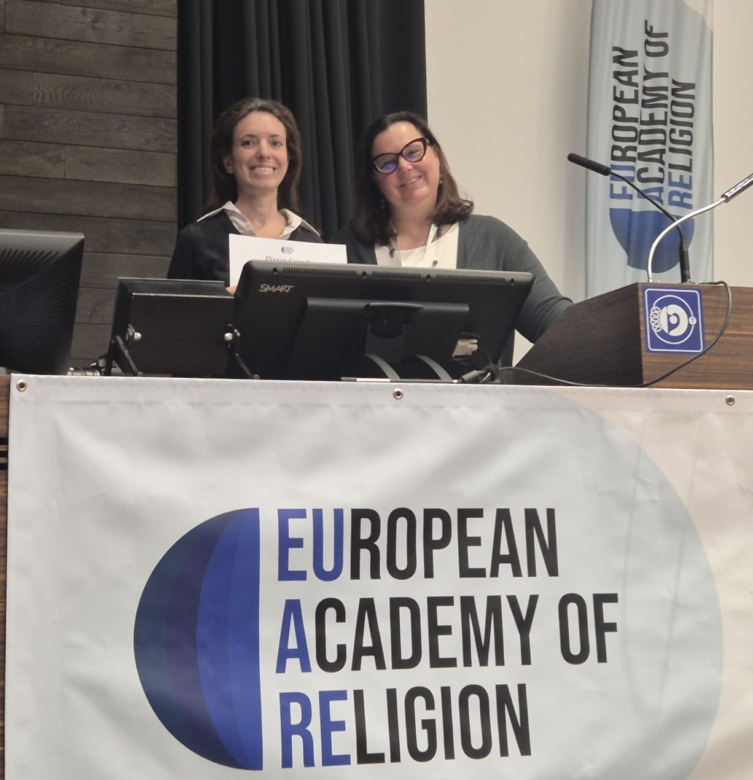Recipients of the 4th Piazza Grande Religion Journalism Award announced in Vienna
“It is a recognition of what we do. We always hope that our work has also an impact. And if through this award more people come to know about peace initiatives in the West Bank and what people do, that will be, for sure, a reward.”
With Nachbarschaftshilfe – Neighbourly and her reporting on peace initiatives by settlers and Palestinians in the West Bank, Serena Bilanceri was awarded the 4th “Piazza Grande” Religion Journalism Award by the International Association of Religion Journalists (IARJ) and the Fondazione per le Scienze Religiose Giovanni XXIII (FSCIRE).

The international jury awarded second place to freelance reporter Tobias Asmuth for his piece Ade Maria, a portrait of the head of the Vatican observatory for apparitions and mystical phenomena related to the figure of the Virgin Mary.
Third place went to German journalist Pia Stendera for Was, wenn niemand weint? – What if no one cries?, about people who died alone and are not mourned.
The jury also gave an honourable mention to freelance journalist Elisa Belotti of Italy for her Niente da curare – Nothing to cure, investigating “conversion therapy”.
The recipients of the award and the honourable mention were officially announced by IARJ Managing Director Elisa Di Benedetto at the annual conference of the European Academy of Religion, in Vienna-Austria, on 8th July, 2025.
Here are the Jury’s statements on the awarded entries:
First Place
Nachbarschaftshilfe, by Serena Bilanceri for Taz.
A timely — and fresh — look at both sides in the fraught issue of the Israeli settlements in the West Bank, presenting helpful context, history and statistics to illustrate those complications in vivid, nuanced details.
Though realistic and fact-based, Bilanceri tells the story of would-be peacemakers and their distinct faith that leaves readers with a story of hope.
The storytelling is rich with details and personal stories.
“When I researched the article, the situation in the West Bank was already extremely tense and initiatives such as those described in the article were having a hard time getting heard. Members were worried about their own safety. But I was struck by the unshakable faith of these people, of different religions, in a future peace and in goodness as something inherent to all human beings, independently from their faith, culture or beliefs.”
Serena Bilanceri
Listen to Serena Blanceri’s interview on RESILIENCE website.
Second Place
Ade Maria, by Tobias Asmuth for Das Magazin / Tages Anzeiger.
Asmuth provides a fascinating profile of nun Daniela Del Gaudio, the colorful woman who determines whether an alleged Marian apparition is legitimate or not – using a type of rational, research-based investigation that includes history, theology and cultural context.
A timely and compelling story, both critical and passionate, about a fresh topic that many journalists have overlooked.
“I am a Catholic, but have always had difficulty believing in Marian apparitions. But I believe that the wave of Marian apparitions in recent years says a lot about the state of our world and perhaps also our search for hope and consolation.”
Tobias Asmuth
Third Place
Was, wenn niemand weint?, by Pia Stendera for Die Zeit.
Stendera explores what it means for bodies to be unclaimed and perhaps unmourned in modern Germany society through the eyes of one clergyman who is determined to not let that happen.
The writing is crisp, the article is well-structured and raises questions everyone can relate with.
“Besides working as a journalist, I work voluntarily in a hospice. Growing up in Eastern Germany, I never felt a connection to religion. But the work in the hospice brought up questions that are sometimes answered best by religious institutions. One is the question: Who remembers people who die but don’t have any relatives?”
Pia Stendera
Honourable Mention
Niente da curare, by Elisa Belotti – with graphic by Nicolò Pellizzon – for La Revue Dessinée Italia.
Difficult but important story about “conversion therapy” – the practice often used by conservative religious groups to make homosexual people straight.
The use of the graphic novel format was gripping and compelling, just a different way to approach the issue.
The piece is hard-hitting, but eye-opening, insightful and impactful.
“I am a journalist committed to investigating hidden injustices and giving voice to those who are often silenced. Conversion therapies, that continue to harm LGBTQ+ individuals under the guise of care, are rooted in pseudoscience and prejudice. They are still allowed in many contexts, particularly within religious communities, despite their devastating psycological consequences.”
Elisa Belotti
The IARJ and FSCIRE wish to thank all the participants in the contest for entering their stories to the fourth edition of the Piazza Grande Religion Journalism Award.
The international Jury included the following journalists: Alberto Melloni (Italy), Jelena Jorgacevic (Serbia), Ken Chitwood (Germany), Melanie Lindman (Middle East), Peggy Fletcher Stack (USA), Robin Sheeran (United Kingdom).
Elisa Di Benedetto was the IARJ coordinator of the award.
